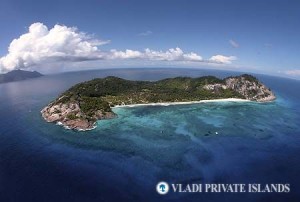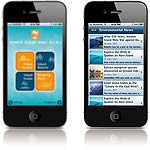A delegation from the Seychelles Ministry of Environment, Energy and Climate Change called by at North Island to witness the private island’s progress to becoming an ecological giant.
During an official visit earlier this week, the Seychelles’ Principal Secretary for the Environment, Alain de Comarmond, took a walk on the wild-side of North Island in order to find out first-hand how one of the world’s most exclusive private island hideaways has helped to rescue some of the Republic’s rarest breeds of flora and fauna.
The recently-elected Minister took great pleasure from exploring the entirety of the 2 km² island and was amazed to witness the fruits borne of owner Wilderness Safari’s labour. Indeed, as well as re-introducing the likes of the Aldabra Giant Tortoise to the island’s sandy shores, the company (re-)-established all sorts of endemic flora, including takamaka, badamier and coco-de-mer trees (also known as the largest seed in the world).
Despite the impressive eco-credentials of these giant seeds and tortoises, however, it was something a lot smaller which stole the show during the delegation’s visit to the island. Indeed, as Minister Comarmond and his team found out to their great surprise – the real success story on North Island is that of the Seychelles White-Eye Bird – a tiny olive-coloured bird long since thought to be extinct.
–
Rediscovered in Mahé in the 1960s and in larger numbers on the Island of Conception in the 1990s, the Seychelles White-Eye Bird once believed to be one of the rarest avians on the planet – a species in grave danger of extinction due to forest clearings and an abundance of predator’s including rats and the Indian Mynah Bird.
Keen to secure a long-term future for the birds, the Seychelles’ Island Conservation Society set about transferring small quantities of the sweet-sounding birds into new surroundings where they had a better chance of survival. After initial attempts at rehousing the birds on the likes of Fregate Island and Cousine Island, the conservation group transported a number of Seychelles White-Eyes to North Island.
Within the lush surroundings of the North Island’s indigenous tree nursery, the White Eyes have been able to thrive – going on to quadruple their number. According to a member of North Island’s Environmental Team, there are now thought to be over 100 birds living on the island – a statistic that has certainly put a smile on the face of the Minister for the Environment.
“The Seychelles White-Eye is a flagship programme for North Island,” explained Minister de Comarmond. “It shows that the conservation program that has been put in place is working very well. The vegetation rehabilitation program is also going really well, and we, as representatives of the Government, are here to facilitate and assist where we can. This visit is only the start.”
–
North Island – A Divine Destination with Humble Beginnings
Forming one of the world’s most divine destinations, North Island is one of the planet’s few private island escapes that can truly be described as being a residence fit for a King after The Duke and Duchess of Cambridge gave it the royal seal of approval during their honeymoon all the way back in 2011.
Yet there’s more to this opulent escape than simply six-star seclusion. As well as being a firm favourite of the international jet-set, North Island has – along with the likes of Seychelles neighbours Fregate, Cousine and Denis – long-since adopted an admirable approach to safeguarding the vast biodiversity of the Seychelles Archipelago, working alongside dedicated conservation experts in order to protect the country’s beautiful biodiversity.
The high-end hideaway wasn’t always at the forefront of island eco-tourism, and once formed a thriving copra plantation during the country’s colonial era before being abandoned by its owner upon the collapse of the coconut industry in the 1970s. Years later, the island was eventually sold to South African eco-tourism specialists Wilderness Safaris, who, with the help of Vladi Private Islands GmbH – picked up the island for just USD 5 million in 1997.
Since then, Wilderness Safaris has invested many more millions of dollars into the island in a transformation which has truly turned the clock back on this incredible Seychelles island gem. Gone are the scars of the colonial era and in their place an opulent escape has emerged providing refuge for 22 guests and a whole host of exotic – and, as the Seychelles Government Delegation this week found out – endangered animals.
Read more:
Private Island News promises to bring you more stories about this pristine private island’s enviable approach to eco-tourism in the not-too-distant future. If you can’t wait until then, however, the following links will be sure to keep your appetite sated!
- Denis Private Island Wins Environmental Accolade (December 2013)
http://www.privateislandnews.com/seychelles-denis-private-island-wins-environmental-accolade/
- Frégate Private Island Adopts Rare Warblers (January 2012)
http://www.privateislandnews.com/seychelles-fregate-private-island-adopts-rare-warblers/ - Royal Honeymoon Still Fuels Tourism Including to Private Isles (July 2011)
http://www.privateislandnews.com/royal-honeymoon-still-fuels-tourism-including-to-private-isles/





